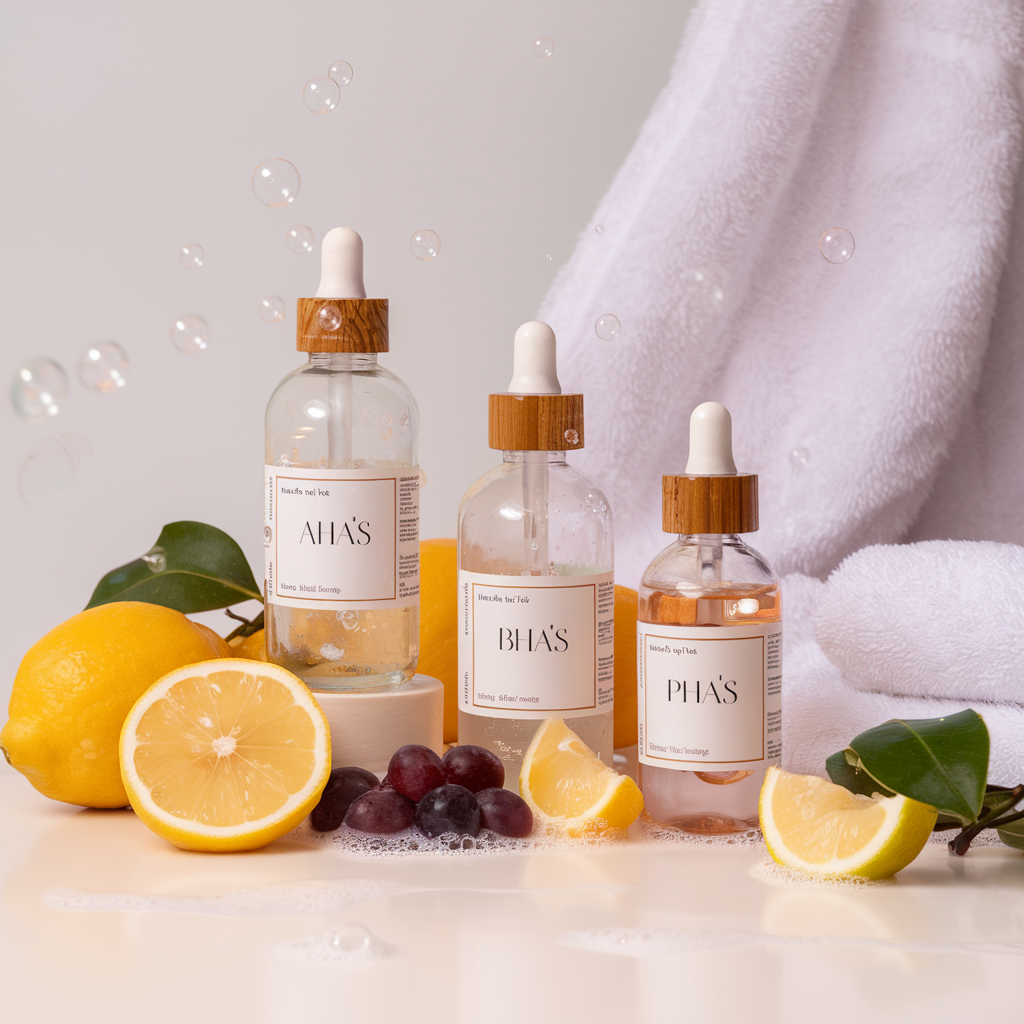Introduction to Chemical Exfoliants: AHAs, BHAs, and PHAs
Did you know that 92% of women believe exfoliation is key to healthy skin? This statistic highlights the growing importance of understanding chemical exfoliants like AHAs, BHAs, and PHAs. These ingredients are revolutionizing skincare, especially in acne treatment and skin renewal, addressing a range of skin issues.
In recent years, these powerful chemical exfoliants have transformed the skincare industry, offering effective solutions for various concerns. Among them, three standout acids—Alpha Hydroxy Acids (AHAs), Beta Hydroxy Acids (BHAs), and Polyhydroxy Acids (PHAs)—have become essentials in many skincare routines, promising clearer, brighter, and more youthful-looking skin. But what exactly are these acids, and how do they differ? Let’s dive into the world of chemical exfoliants and uncover their secrets.
What are chemical exfoliants?
Chemical exfoliants break down dead skin cells gently. They are different from physical scrubs. These ingredients go deep into the skin, helping with cell turnover and deep cleansing. Each chemical exfoliant has its own benefits:
| Exfoliant | Key Benefits | Best For |
|---|---|---|
| AHAs | Surface exfoliation, hydration | Dry, sun-damaged skin |
| BHAs | Deep pore cleansing, oil control | Oily, acne-prone skin |
| PHAs | Gentle exfoliation, hydration | Sensitive skin |

Understanding AHAs (Alpha Hydroxy Acids)
AHAs break down dead skin cells, making them easy to shed, revealing fresh, youthful skin underneath. They also reduce inflammation, making them suitable for sensitive skin. By speeding up cell turnover, AHAs improve skin texture and appearance.
There are several types of AHAs used in skincare, each derived from different natural sources:
- Mandelic acid (from bitter almonds)
- Glycolic acid (from sugar cane)
- Lactic acid (from milk)
- Citric acid (from citrus fruits)
- Malic acid (from apples)
Exploring BHAs (Beta Hydroxy Acids)
Beta Hydroxy Acids (BHAs) are strong chemical exfoliants great for oily and acne-prone skin. They dissolve deep into pores, making them perfect for controlling oil and removing blackheads.
To get the best results, use BHAs in your skincare routine 2-3 times a week. Start with lower concentrations and slowly increase as your skin gets used to it. Always apply a moisturizer and sunscreen after, as BHAs can make your skin more sensitive to the sun.
| Skin Concern | BHA Effectiveness |
|---|---|
| Oil Control | High |
| Blackhead Removal | Excellent |
| Acne Treatment | Very Effective |
| Pore Size Reduction | Moderate |
Discovering PHAs (Poly Hydroxy Acids)
PHAs have a larger molecular structure compared to AHAs and BHAs, which means they penetrate the skin more slowly and gently. This gradual action makes them suitable for sensitive skin types that might find other acids too harsh.
Beyond exfoliation, PHAs offer hydrating and antioxidant properties. They can help strengthen the skin barrier, making them a great choice for those looking to improve overall skin health.
Comparing AHAs, BHAs, and PHAs
| Aspect | AHAs | BHAs | PHAs |
| Penetration | Surface-level | Deep into pores | Gradual, surface-level |
| Best for | Dullness, fine lines | Acne, oiliness | Sensitivity, hydration |
| Skin Types | Normal to dry | Oily, acne-prone | All, especially sensitive |
| Sun Sensitivity | Increases | Minimal | Minimal |
| Hydration | Can be drying | Can be drying | Hydrating |
Incorporating Acids into Your Routine
- Start Slow: Begin with lower concentrations and fewer applications per week, gradually increasing as your skin adjusts.
- Layering: Generally, apply acids after cleansing and before moisturizing. Wait a few minutes between layers to allow each product to absorb.
- Combination Use: You can combine different acids, but be cautious. For example, use BHA in the morning for oil control and AHA at night for surface exfoliation.
- Listen to Your Skin: If you experience irritation, redness, or excessive dryness, reduce usage or consult a dermatologist.
- Sun Protection: Always use a broad-spectrum sunscreen during the day, especially when using AHAs.
Conclusion
Understanding the differences between AHAs, BHAs, and PHAs is key to choosing the right exfoliant for your skin. Whether you’re battling acne, seeking anti-aging benefits, or looking for a gentle way to brighten your complexion, there’s an acid that’s right for you. Remember to assess your skin type and concerns carefully, and don’t hesitate to consult with a skincare professional for personalized advice. With the right approach, these powerful ingredients can transform your skincare routine and help you achieve the glowing, healthy skin you desire.
